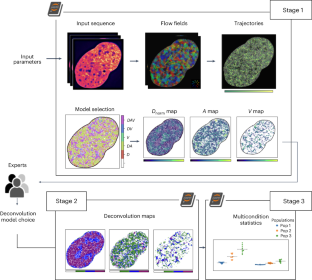Genome-wide analysis of the biophysical properties of chromatin and nuclear proteins in living cells with Hi-D
IF 16
1区 生物学
Q1 BIOCHEMICAL RESEARCH METHODS
引用次数: 0
Abstract
To understand the dynamic nature of the genome, the localization and rearrangement of DNA and DNA-binding proteins must be analyzed across the entire nucleus of single living cells. Recently, we developed a computational light microscopy technique, called high-resolution diffusion (Hi-D) mapping, which can accurately detect, classify and map diffusion dynamics and biophysical parameters such as the diffusion constant, the anomalous exponent, drift velocity and model physical diffusion from the data at a high spatial resolution across the genome in living cells. Hi-D combines dense optical flow to detect and track local chromatin and nuclear protein motion genome-wide and Bayesian inference to characterize this local movement at nanoscale resolution. Here we present the Python implementation of Hi-D, with an option for parallelizing the calculations to run on multicore central processing units (CPUs). The functionality of Hi-D is presented to the users via user-friendly documented Python notebooks. Hi-D reduces the analysis time to less than 1 h using a multicore CPU with a single compute node. We also present different applications of Hi-D for live-imaging of DNA, histone H2B and RNA polymerase II sequences acquired with spinning disk confocal and super-resolution structured illumination microscopy. High-resolution diffusion uses a dense optical flow algorithm to quantify and classify the motion of nuclear macromolecules, assigning biophysical parameters such as the diffusion constant, the anomalous exponent and the drift velocity.


利用 Hi-D 对活细胞中染色质和核蛋白的生物物理特性进行全基因组分析。
要了解基因组的动态特性,就必须分析 DNA 和 DNA 结合蛋白在单个活细胞整个细胞核中的定位和重排情况。最近,我们开发了一种名为高分辨率扩散(Hi-D)映射的计算光学显微镜技术,它可以准确地检测、分类和映射扩散动态和生物物理参数,如扩散常数、反常指数、漂移速度和活细胞中基因组的高空间分辨率数据中的物理扩散模型。Hi-D 结合了高密度光流检测和跟踪全基因组局部染色质和核蛋白运动,以及贝叶斯推理以纳米级分辨率描述这种局部运动。在此,我们介绍了 Hi-D 的 Python 实现,并提供了在多核中央处理器(CPU)上并行计算的选项。Hi-D 的功能通过用户友好的 Python 笔记本向用户展示。Hi-D 使用单个计算节点的多核 CPU 将分析时间缩短到 1 小时以内。我们还介绍了Hi-D在DNA、组蛋白H2B和RNA聚合酶II序列的实时成像中的不同应用,这些序列是用旋转盘共聚焦显微镜和超分辨率结构照明显微镜获得的。
本文章由计算机程序翻译,如有差异,请以英文原文为准。
求助全文
约1分钟内获得全文
求助全文
来源期刊

Nature Protocols
生物-生化研究方法
CiteScore
29.10
自引率
0.70%
发文量
128
审稿时长
4 months
期刊介绍:
Nature Protocols focuses on publishing protocols used to address significant biological and biomedical science research questions, including methods grounded in physics and chemistry with practical applications to biological problems. The journal caters to a primary audience of research scientists and, as such, exclusively publishes protocols with research applications. Protocols primarily aimed at influencing patient management and treatment decisions are not featured.
The specific techniques covered encompass a wide range, including but not limited to: Biochemistry, Cell biology, Cell culture, Chemical modification, Computational biology, Developmental biology, Epigenomics, Genetic analysis, Genetic modification, Genomics, Imaging, Immunology, Isolation, purification, and separation, Lipidomics, Metabolomics, Microbiology, Model organisms, Nanotechnology, Neuroscience, Nucleic-acid-based molecular biology, Pharmacology, Plant biology, Protein analysis, Proteomics, Spectroscopy, Structural biology, Synthetic chemistry, Tissue culture, Toxicology, and Virology.
 求助内容:
求助内容: 应助结果提醒方式:
应助结果提醒方式:


